 Mars Symbol |
 |
 Mars Symbol |
 |
Mars has always been of interest to astronomers and the public, in part due to its proximity. Unlike Venus, surface features can be seen even with a small telescope. You can see variations in the planet over time - during the change of Martian seasons. Astronomers (and non-astronomers) noted that light and dark areas on the surface appeared to change their sizes over the course of a Martian year. People speculated that these variations could be due to vegetation, just like how the surface of Iowa changes as plants develop and grow over the seasons. Other things that can be seen from the Earth are the polar ice caps, and it is easy to see them change in size over the course of the Martian year, just like Earth's own polar ice caps. Also, the length of the Martian day is very close to that of the Earth's (24 hours and 37 minutes). Also, the tilt of Mars's rotation axis is about 24 degrees, which is very similar to the Earth's. With all of these features that were seen on Mars that could be identified with similar features on the Earth, people were rather curious about just how much Earth and Mars were alike - for instance, could there be life on Mars? Could there be Martians? Most importantly, do they have digital cable tv? Perhaps that wasn't one of the big concerns, but you can see why people have long been interested in Mars..
Things became very complicated in 1877 when the Italian astronomer Giovanni Schiaparelli described many lines criss-crossing the surface of Mars. He thought that they might be water channels, which in Italian is written as canali (even though there are dry water channels on Mars it is unlikely that he did observe them, since even with the best telescopes today these features can't be seen from the Earth). Now you must remember, channels can be naturally occurring things, while canals are built. People looking through Schiaparelli's work came across his mention of canali and thought "gosh, this fellow has seen canals on Mars!" He never said he did, but people who didn't know what Schiaparelli actually intended to say (channels) just jumped the gun and made the conclusion that this fellow observed canals on Mars.
Of course, if there are canals then someone (or something) must have built them! Oh, dear, many people thought, there may actually be Martians! One person who thought there was life on Mars was Percival Lowell, a rich Bostonian with too much free time and money on his hands. He actually had an observatory built to study Mars (and other things - Lowell observatory in Arizona). In the 1890s he spent a great deal of time making detailed maps of the surface of Mars showing features such as lines, canals, cities, farm lands (he mapped up to 160 canals). His publications and theories behind the Martians, their canals and their cities were widely read by the public, though professional astronomers didn't think he was correct. But who ever listens to professional astronomers? Lowell's ideas had enough of an influence that people sometimes mistook his theories for proven facts.
When science fiction writers like H.G. Wells and Edgar Rice Burroughs wrote their stories, they often used the "information" derived by Lowell and others who believed in the existence of Martians. The general public as well had perceptions that life existed on Mars, or at least it seemed reasonable to most people. This was made very obvious in the panic that occurred when Orson Welles dramatized in a radio show a Martian invasion of the Earth in 1937. Many people actually thought it was going on (whether this had to do with the quality of Orson Welles's work or the gullibility of people, you can decide). I have to wonder about some people, since in Orson Welles's dramatization the Martians invaded New Jersey, which is probably not very high on many Earth invaders' lists of first targets.
Why did people really think that there were Martians? In part, because the ideas presented by Lowell and others made so much sense. The basic idea was that Mars was a desert world that relied on the elaborate canal system to bring water from the icy polar caps to lower latitudes to grow food. This would explain the changing surface features over the Martian year. As crops grew the color of the land changed. Of course, if the Martians were so advanced that they could build canals that crossed the surface of the planet, then they must be advanced in other respects as well. Perhaps they have telescopes and with those telescopes they might observe our world - our blue, water covered world. If the Martians are desperate for water, wouldn't they love to come here and get our water (and, of course, destroy major cities and landmarks along the way, until someone like Will Smith or Jeff Goldblum saved the day - oops, that was a different set of alien invaders - never mind)? At least, that is what some people thought. You also have to remember what the world was like around the early 1900s - things like canals were very common on the Earth and in the lives of many people, and things like rockets were part of popular literature.
Is this really true? How do we know what Mars is really like? The only way to really study Mars is to go there. Over the years, the US and the former Soviet Union have sent quite a few probes to study Mars. However, unlike the success that they had with studying Venus, the Soviet probes were not so successful - pretty much all of them failed for a variety of reasons. While the US probes haven't been entirely successful, we have been pretty good at exploring Mars. Amongst the more prominent projects are -
 |
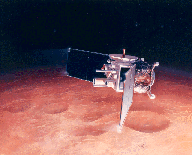 |
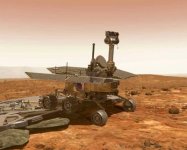 |
 |
| Figure 1. Spacecraft and rovers that
have studied and are currently studying Mars. From left to right,
Pathfinder (with the rover Sojourner analyzing a rock), the Mars Global
Surveyor, the rover Spirit rolling off of its
spacecraft, and the Curiosity rover ready to examine the surface of Mars. |
|||
The missions sent in the 1960s and 1970s were rather elaborate, for there was enough money in those days so that two spacecraft could be sent (like the Viking mission). Now the policy for NASA is to send small, simple spacecraft to study planets (the faster and cheaper policy). While this can provide some rather dramatic results, at times the limitations of the systems are annoying. It has actually been a bit of a problem, since in the late 1990s two such spacecraft failed upon arrival at Mars. While some people think faster-cheaper might be good for the budget, it is bad for science. Unless the budget changes, this policy probably won't change. That's enough political discussion; let's get back to the science!
What is Mars REALLY like? While it might be nice to think that you could handle the conditions on Mars, that will depend upon which part of Mars you are on. This is because the orbit of Mars is much more elliptical than the Earth's, and this has an effect on the severity of the seasons in the northern and southern hemispheres. When Mars is at perihelion (near the Sun), the southern hemisphere is tilted toward the Sun while the northern hemisphere is tilted away. At this time it gets pretty hot in the south (where it is summer), while in the north it isn't such a harsh winter. The situation is reversed at the Martian aphelion (when it is far from the Sun), when the north is experiencing summer and the south is experiencing winter. Again, the distance from the Sun has an influence, in this case making the southern winter pretty cold and the northern summer fairly mild. Obviously, you would want to be located in the northern hemisphere unless you really like extreme weather conditions, like Minnesotans. The surface temperature on Mars is most like that at the Earth's south pole, ranging from very cold to being rather toasty during the summer - often very toasty in the southern hemisphere during summer. The temperature variations would not be too painful for humans.
 Figure 2
The great variations of Mars's seasons is due to its extreme orbit. The
ice caps change size during the seasons as can be expected. This
image is not shown to scale.
Figure 2
The great variations of Mars's seasons is due to its extreme orbit. The
ice caps change size during the seasons as can be expected. This
image is not shown to scale.
There is another side effect from the change in the distance between Mars and the Sun. During the time of perihelion, the temperature differences between the day and the night time sides of the planet cause the atmosphere to become more unstable. Basically, there are a lot of winds at this time, and since there is a great deal of dust on the surface, this is picked up by the winds. The result is that dust storms will develop first in the southern hemisphere, but they can get large enough to cover the entire planet. These are what the astronomers saw changing the surface features during the Martian seasons - not vegetation or life. It is also interesting to note that these storms would develop during the time of perihelion - when Mars was close to the Sun. At certain times, this is also when Mars was closest to the Earth, and there was a lot of interest in viewing Mars at such times. If those views showed a changing surface (due to the dust storms), it probably influenced the observers a great deal.
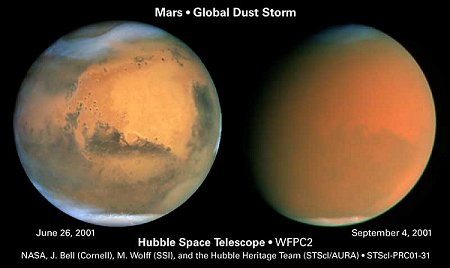 Figure 3. Images from the Hubble Space telescope
showing the changing appearance of Mars due to global dust storms. The
image on the left is the "before" view - surface markings and colorings
are clearly visible. The image on the left shows the global dust
storm's affect on the view - this is the "after" picture. The
surface details are washed out by the dust in the atmosphere, making
Mars look rather smooth and basically boring. Image credit: NASA, James
Bell (Cornell Univ.), Michael Wolff (Space Science Inst.), and the
Hubble Heritage Team (STScI/AURA).
Figure 3. Images from the Hubble Space telescope
showing the changing appearance of Mars due to global dust storms. The
image on the left is the "before" view - surface markings and colorings
are clearly visible. The image on the left shows the global dust
storm's affect on the view - this is the "after" picture. The
surface details are washed out by the dust in the atmosphere, making
Mars look rather smooth and basically boring. Image credit: NASA, James
Bell (Cornell Univ.), Michael Wolff (Space Science Inst.), and the
Hubble Heritage Team (STScI/AURA).
Mars has dust storms, so it obviously has an atmosphere. Let's look at that in some more detail. In terms of composition, here's the breakdown of the elements -
It is sort of interesting to note that the chemical composition of Mars's atmosphere is most like that of Venus, but there the similarity ends. While Venus's atmosphere is very thick and oppressive, Mars's is much more diluted. The atmospheric pressure is about 1/100th the Earth's, so you would have a hard time getting a lung full of air (this aspect of Mars's atmosphere was highlighted in the movie Total Recall, though it was exaggerated a bit there). The atmospheric pressure does change drastically over the seasons as CO2 goes from an ice form into the atmosphere at the pole experiencing summer, and at the same time it will condense out of the atmosphere and become ice at the pole that is experiencing winter.
In 2009 scientists detected traces of methane in the atmosphere. What does that indicate? Methane is a gas that can originate from biological organisms, or from volcanism. While it looks like Mars appears to be geologically dead (no active volcanoes), it is possible for very low level activity to exist. And the other possibility also exists - that life may be the source for this, but this would be microscopic forms of life below the surface. We'll just have to wait and see if there are more observations of this in the future.
Even though there is so little water in the atmosphere, there is 100% humidity on Mars. The atmosphere is full of water, but since it is so thin, there isn't really all that much water in the atmosphere (compared to the Earth). If there was any more water in the atmosphere, it would condense and form frost or snow. A rather interesting aspect of Mars's atmosphere is that water cannot be in a liquid state. It can only be in the form of a gas or a solid (ice or frost). Most of the clouds seen on Mars are water vapor clouds and there is also some water ice seen in the ice caps. On really cold days, some of the water vapor can form as frost on the ground.
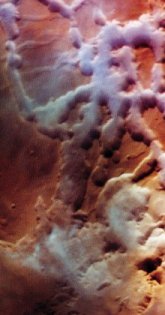 Figure 4.
Foggy weather on Mars is shown, with some of the low lying clouds seen
in a complex valley structure. Image from NASA.
Figure 4.
Foggy weather on Mars is shown, with some of the low lying clouds seen
in a complex valley structure. Image from NASA.
The internal structure of Mars is a bit different from that of the Earth, in part because of its lower mass. Mars doesn't have as much material as the Earth, so there is less internal heating. It also has a much lower density, which indicates that there isn't as much iron as in the core of the Earth. Mars is mainly made of rock. Even though it spins around as fast as the Earth, there isn't a lot of iron in the core. The basic upshot is that there is a very weak and disorganized magnetic field. Actually, there are magnetic fields detected on only certain parts of Mars.
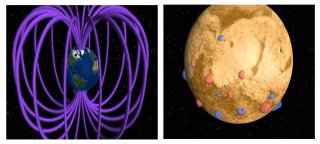 Figure 5. The magnetic fields of the Earth and Mars
are compared. Earth's is pretty simple, with one magnetic pole in the
north and the other in the south. Mars has magnetic bumps all over the
place, with small fields existing in only limited areas. The lack of a
major magnetic field structure points to a lower iron content in the
interior of Mars as well as less internal heat (so the core, if it
exists, can't be very mobile). Image from NASA.
Figure 5. The magnetic fields of the Earth and Mars
are compared. Earth's is pretty simple, with one magnetic pole in the
north and the other in the south. Mars has magnetic bumps all over the
place, with small fields existing in only limited areas. The lack of a
major magnetic field structure points to a lower iron content in the
interior of Mars as well as less internal heat (so the core, if it
exists, can't be very mobile). Image from NASA.
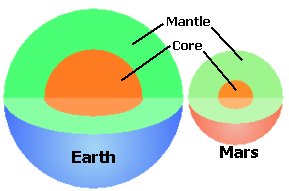 Figure 6.
The internal structures of the Earth and Mars. The size of the core of
Mars is not well known; it may be larger than is shown here, but it is
probably not mobile or as iron rich as the Earth's core.
Figure 6.
The internal structures of the Earth and Mars. The size of the core of
Mars is not well known; it may be larger than is shown here, but it is
probably not mobile or as iron rich as the Earth's core.
All of the spacecraft that have visited Mars have provided us with the chance to compare its surface features to those of the Earth. In this respect, Mars is the most similar in appearance to the Earth. There are many features seen on Mars that are also present on the Earth. These include
Of course the surface is red in color due to oxidation of the soil - basically a rusting of the iron in the soil. Let's take a peak at some of the more interesting surface features.
 |
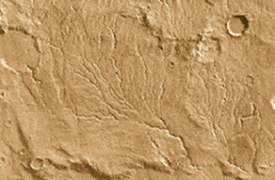 |
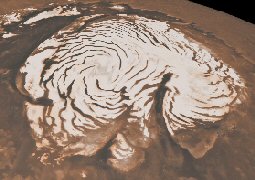 |
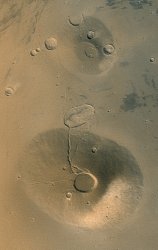 |
Figure 7. Several surface features seen on Mars, including a crater (upper left - this one is called the Smiley Face crater - can you see it?), dry water channels (upper center), ice caps (upper right) and volcanoes (left). Images from NASA/JPL/MSSS. | |
As with Venus, Mars does not appear to have any plate tectonics,
though it does have one structure that could be thought of as a
continent - a region raised above the surroundings. This is the feature
known as the Tharsis Bulge. It
is a large plateau with several massive volcanoes located on top of it.
Tharsis is raised about 10 km above the surrounding terrain. The
volcanoes on it have been extinct for some time, as have all of the
volcanoes on Mars.
 |
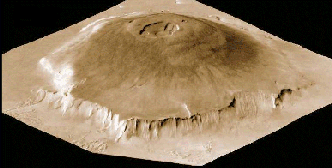 |
Figure 8. Olympus Mons as seen from above and from the side. Image from NASA. |
The main volcano, and also the highest mountain in the solar system, is Olympus Mons. This critter is about 600 km across, reaching an overall height of about 25 km. For comparison, the volcano that makes up the big island of Hawaii, Mauna Loa, is only about 10 km high. Olympus is very similar to Mauna Loa and the other basaltic shield volcanoes on the Earth since it is very wide and spread out. Like the volcanoes of Hawaii, it and the other volcanoes on Tharsis are hot spot volcanoes, created by a plume of material that breaks through the surface.
As was already mentioned, Mars is a much smaller and therefore much cooler planet than the Earth, so why is Olympus so big? You would only expect such large objects on worlds that would be very active and have a great deal of internal heat, right? - not quite. While it is a similar volcano to the Hawaii ones, there is the important difference that there does not appear to be any plate motions on Mars as on the Earth. Due to this, the one hot spot would have continually fed its material to the same location. Also, the low surface gravity on Mars allows larger structures to be built up. On the Earth where gravity is about three times greater than on Mars, the weights of mountains will tend to cause them to not get very large since they tend to sink down.
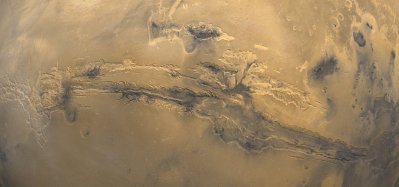 Figure 9.
Valles Marineris. Image from NASA.
Figure 9.
Valles Marineris. Image from NASA.
Not too far from the edge of the Tharsis Bulge is another very significant feature, the Valles Marineris, a 4000 km long rift feature. This is about the same distance as between New York and Los Angeles. In places it gets to be about 6 km deep and 200 km wide. It should be noted that even though it looks like a river channel (like the Grand Canyon), it is not a water feature but a crack in the surface of the planet. Why such a large crack would be on such a small planet is another mystery. If you'd like to fly through the valley, just click here for a big quicktime video through it.
![]() Figure 10. (Click to see larger version)
The elevation map of Mars is shown (from the Mars Global Surveyor
project). The two hemispheres show a wide range of elevation, with the
north having a lower elevation and the south having a higher elevation.
The Tharsis bulge and Valles Marineris stand out easily.
Figure 10. (Click to see larger version)
The elevation map of Mars is shown (from the Mars Global Surveyor
project). The two hemispheres show a wide range of elevation, with the
north having a lower elevation and the south having a higher elevation.
The Tharsis bulge and Valles Marineris stand out easily.
When you look at the overall surface features of Mars, there are some rather interesting ways that these features are arranged. First of all, both the Tharsis bulge and Valles Marineris are located close to the equator. If you look at the northern hemisphere, you'd see that it is relatively smooth with very little cratering. This is also where you tend to see volcanoes. In the south there are many more craters and some large impact basins. Also the elevation in the south is significantly higher than in the north, which makes the planet a bit unbalanced. Mars is sort of like the Moon in that one side of the world is quite different from the other, but in this case, it is the northern and southern hemispheres that are different. Based on the numbers and sizes of the craters in the north, it is thought that there were active volcanoes as recently as 1 billion years ago. That isn't what you might think of as recent, but it does support the age difference between the two hemispheres. In early 2008 it was suggested that the northern part of Mars was smoothed out due to a massive impact that may have occurred 3.9 billion years ago. This would have also caused it to have a lower elevation. You can read about this theory at this link.
It is also worth noting that, especially in the north, there are many dry river channels and also indications of large scale flooding. Wait a minute! Didn't I say that water can't exist as a liquid on the surface of Mars, that it would immediately evaporate or freeze? If that's true, how could you have flood features and other water-related structures?
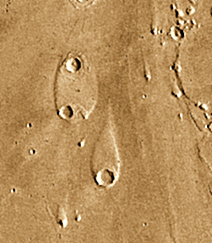 |
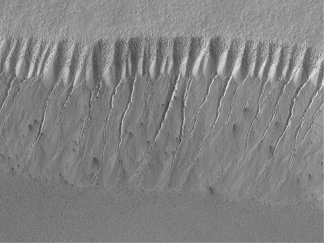 |
Figure 11. Evidence of water on the surface of Mars both in the past and currently. The image at the far left is of water shaped features, comprised of impact craters and then tear-drop shaped forms around them, most likely due to the flow of a great deal of water. The image directly to the left is of a crater rim, which has a bunch of flow features in it where water has recently flowed out of. Images from NASA. |
We need to look into Mars's past to answer that question. All we need to do is make Mars's atmosphere thicker (increase the atmospheric pressure/density). If that were to happen, then you could have water in a liquid form on its surface, since its atmospheric temperature and air pressure would be suitable for that to occur. This seems to be situation that must have existed when the large scale water features were formed. If there was water on the surface at one time, where did it all go? We know that there is some water in the polar caps, and there are also indications that there must be a lot of water frozen under the surface in the form of permafrost. In fact, recent observations by the Mars Reconnaissance Orbiter show evidence of recent water features that are seen on the edges of craters that perhaps penetrate the permafrost (frozen water in the soil). In places where the crater walls erode away and expose the water layers, the water quickly flows out and leaves a rather obvious discoloration on the terrain. The neat thing about these findings is that it is seen to repeat according to the Martian seasons. However you need to be cautious about this since some of these features may actually be due to carbon dioxide ice below the surface that evaporates, which may be what is happening here.
The Phoenix lander has uncovered frozen water under the surface of Mars, actually quite close to the surface. If you click on this image you'll see a trench that the lander dug and the white water ice in it. Also, look at the lower left corner of the trench in the two images. In the left image you'll see a couple of chunks of ice, but they are gone in the image on the right. What happened to the ice? It evaporated - technically it sublimated similar to how dry ice on the Earth goes from a solid to a gas state. Current studies suggest that a large part of the planet may have been covered with water in the past, especially in the northern part. Observations by the rovers and orbiting spacecraft have revealed the presence of minerals that are water-formed features. This includes the formation of things like opals (yes, those gem stones), gypsum, various silicates and grey hematite, something which may be produced by water in a liquid form. Large areas of the flat northern hemisphere appear to have terrain that suggest water features, even shorelines. This link leads you to a recent study indicating that large oceans may have existed on the surface of Mars in the past (and I would have to mention that one of the authors of this study, Brian Hynek, is a UNI graduate in Earth Science!). Follow this link to see the edge of a crater explored by the rover Opportunity, which shows extensive layering. However, all of this would have occured a long time ago - a few billion years at least.
If Mars had a water-sustaining atmosphere in the past, why did it change? We're not quite sure of the answer to this. There could have been several causes, one cause or who knows what. A change in weather could have caused the atmosphere to freeze out and that could have been the end of it - no greenhouse effect, no way to thaw the atmosphere. You also have to remember that Mars has a lower gravity, so it is easier for gases to escape out into space. In this case, if the atmosphere were overheated, it may have been lost into space. An impact by a large object may have blown off a large amount of the atmosphere. We do know that Mars, like the Earth, has had epochs of large scale heating as well as times of sustained cooling (ice ages). The end result is that we know at one time there was a substantial amount of atmosphere on Mars, but now it is much thinner.
Here are some animations showing Mars. First there is a general view of Mars put together from various views of the surface (animation from Calvin J. Hamilton). Then there is a view as seen by the Hubble space telescope. In this case, the atmosphere has a slight effect on the view. The last movie shows the topography (elevation) of the surface with the purple areas being very low elevation (animation from NASA).
Mars is rather lucky to have not just one but two satellites. This is mainly due to its proximity to the asteroid belt, where wayward asteroids could be pulled into orbit around Mars. This is probably where these two moons came from since they are very small and asteroid like.
 Asaph Hall
(1829-1907). Photo courtesy of US Naval Observatory Archive.
Asaph Hall
(1829-1907). Photo courtesy of US Naval Observatory Archive.
As you can see, the too moons, Phobos and Deimos, are quite irregular in shape - sort of potato shaped and small. They also appear to have very low densities (mainly rocky), like the objects seen in the asteroid belt. There's not much more that you can say about them.
 |
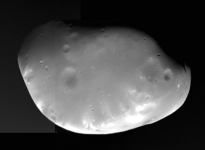 |
Figure 12. Phobos (far left) and Deimos (near left). If you click on each image, you'll see a movie of each moon rotating around. Images from NASA, animations by Calvin J. Hamilton. |
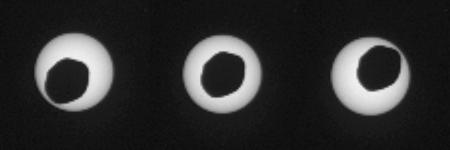 Figure 13.
The moon Phobos passes in front of the Sun as seen by the Curiosity rover.
Image from NASA/JPL-Caltech/Malin Space Science Systems/Texas A&M University.
Figure 13.
The moon Phobos passes in front of the Sun as seen by the Curiosity rover.
Image from NASA/JPL-Caltech/Malin Space Science Systems/Texas A&M University.